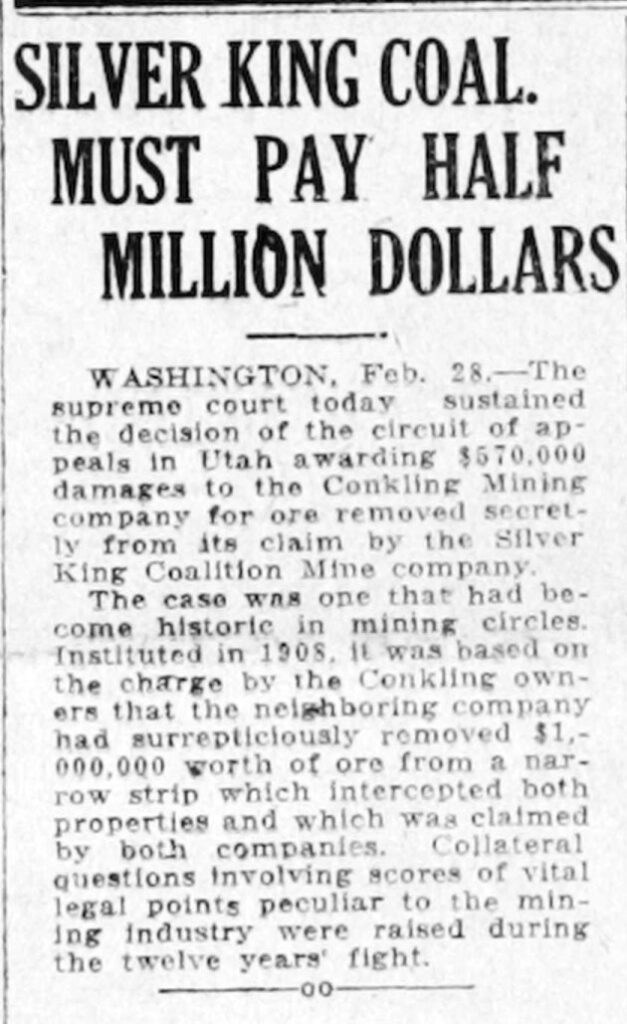This is the thirteenth and final article in a series on the Conkling Mining Co. v. Silver King Coalition Mines Co. lawsuit.
An exuberant Sam Treweek burst into the office of the Park Record early in the afternoon of the last day of February 1921 to proclaim that the Supreme Court of the United States had just handed down a ruling in favor of the Conkling Mining Company in its suit against the Silver King Coalition Mines Company. The report was quickly verified by a call to the Salt Lake newspapers. An Associated Press dispatch announcing the Court’s decision had already been published in the Salt Lake and Ogden evening papers.
SILVER KING COALITION MUST PAY HALF MILLION DOLLARS the Ogden-Standard Examiner’s headline screamed. The story went on to say that the Supreme Court had sustained the Circuit Court of Appeals in awarding $570,000 to the Conkling for ore removed secretly from its claim by the Silver King Coalition.
“Joy radiated from those who were in sympathy with the Conkling side,” the Park Record reported, while “gloom and disappointment were keenly evidenced in the countenance of those supporting the Silver King. Mr. Treweek sadly regretted that his father, Colonel Nicholas Treweek, was not alive to enjoy the “victory of the long fight.”’ Some investors, feeling that the Silver King had lost the suit sold their stock in the company.

Credit: Courtesy of Utah Digital Newspapers, Odgen Standard-Examiner
But by seven o’clock that evening, the United Press reported that the Associated Press dispatch was wrong and that the decision of the Supreme Court had been rendered in favor of the Silver King. The Associated Press, noted for its accuracy, seldom erred; but it had made a grievous mistake in reporting the decision in this important mining case. It had gotten its facts twisted and had the wrong company winning. The United Press report was confirmed by the Salt Lake Tribune. “The sharply piercing disappointment of Mr. Treweek and his friends is easier imagined than described,” the Park Record wrote in its March 4 edition.
Salt Lake Telegram reporter, Ira C. Tichenor, described the decision of the Supreme Court as second only in importance to the mining industry as that of the court sustaining the constitutionality of the apex law. Justice Oliver Wendall Holmes had declared emphatically that the monuments marking corners of mining claims are the governing factors where there is a conflict between the survey and the worded patent. The judgement made monuments the highest authority to which inconsistent descriptions must give way.
John A. Marshall earned the reputation of an able jurist. It was said that he had been reversed in his decisions less frequently by the Supreme Court of the United States than any other district judge in the United States. In the words of Justice Holmes: “We are satisfied that the evidence showing marked posts at the third and fourth corners was admissible, and that witnesses properly were allowed to testify that they found posts upon the ground. The district judge, who saw and heard the witnesses, was satisfied that they told the truth, and thereupon rightly determined that the monuments so fixed controlled the courses and distances in the instrument evidencing the grant.”
To learn more about Park City’s mining history, visit the Park City Museum and its Hal Compton Research Library. The Museum has its second-to-last members-only guided history hike on Sunday, September 26. We will be hiking past the Woodside, Mayflower, and Silver King Mines. Join as member today to access this exclusive experience!